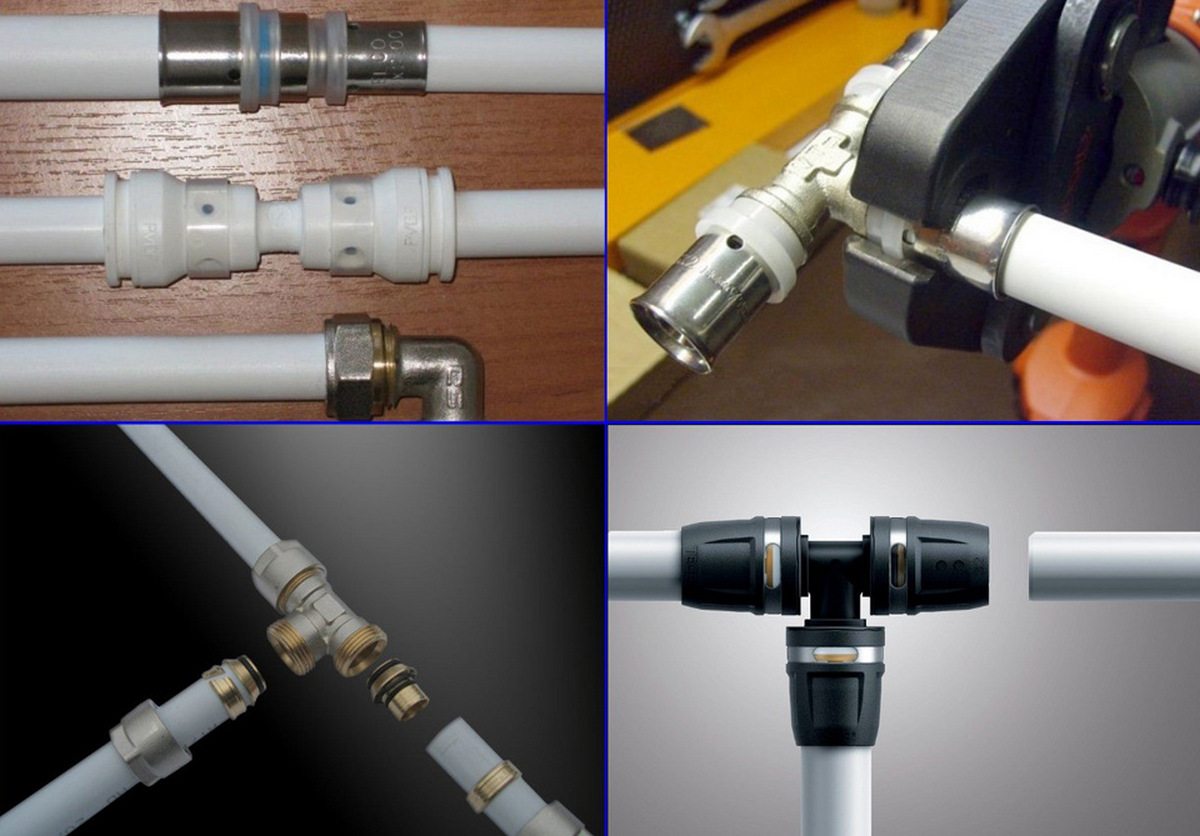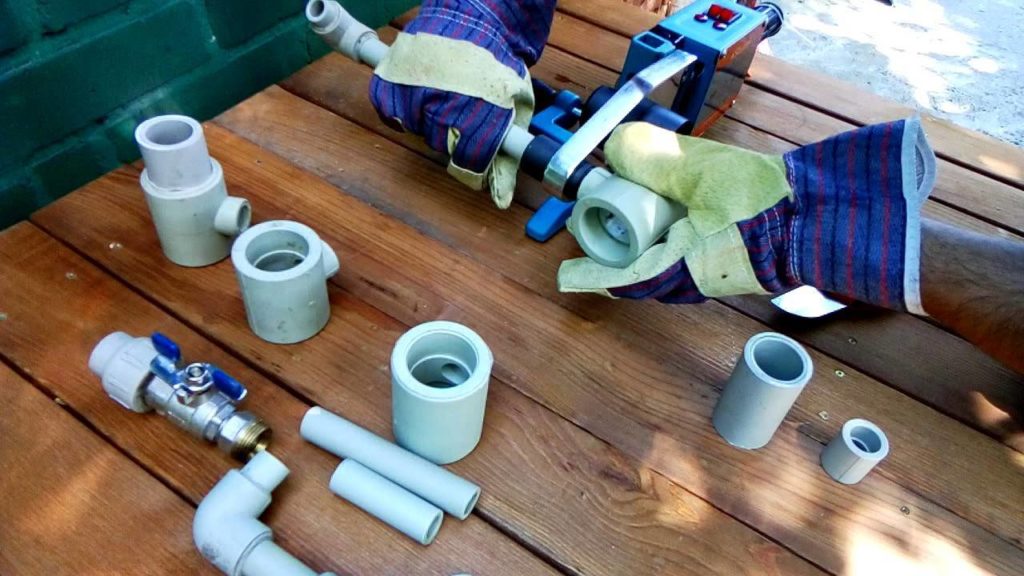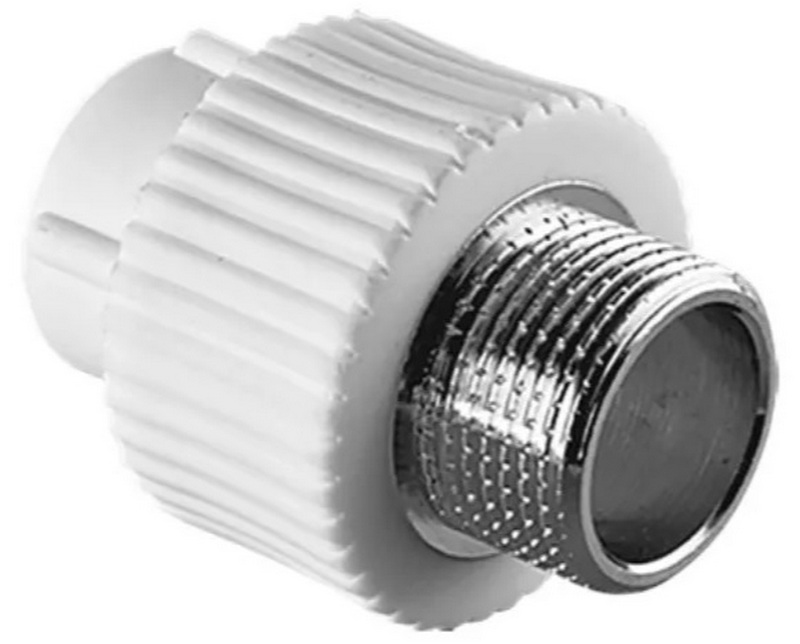Rating of the best fittings for polypropylene pipes for 2022

Polypropylene pipes are usually used to equip heating and water supply systems in private and multi-apartment buildings, as well as at production facilities. Such lines are traditionally assembled from separate segments of 2-4 meters, and the strength of their connection to each other is achieved by welding. At the same time, for laying a high-quality pipeline, it is necessary to permanently take into account the presence of various turns of the line, its branches, as well as the transition of individual sections from plastic pipes to metal ones. Fittings are used in these situations to ensure proper connections. They are elements of hermetic and reliable fastening for various pipe sections. They are presented in the form of a variety of tees, couplings, adapters, etc., the main purpose of which is to facilitate the process of functioning of the entire trunk system.In addition, with their help, even at the stage of construction and initial installation, it is possible to form a very complex pipeline system with many branches, which, however, will not yield to an absolutely straight line in terms of reliability.

Content
General information
A polypropylene fitting is a small part used to connect plastic pipes in pipelines, through which it is possible to change the direction for the main line, as well as connect pipes made of other materials. Among other things, by means of them it is also possible to compensate for the expansion of plastic pipes if a heated coolant flows through them.
Most often, the type of auxiliary devices under consideration is used in heating and water supply systems. At the same time, the more complex and less straightforward the system, the more such devices will be needed during construction and installation work. It is worth mentioning that one of the universal advantages of fittings is that they can be used not only at the stage of initial laying, but also during the modernization and repair of the line.
Technical specifications
Polypropylene fittings, in most of their technical parameters, are similar to pipes made of a similar material. The main indicators include the following:
- Density - this feature is responsible for the ability to withstand the increased pressure produced by the coolant when moving through the pipes, the ability to withstand accelerated abrasion of the inner and outer surfaces, and also indicates the overall hardness and strength. A standard popular fitting (for example, a swivel fitting) should have a tensile strength of at least 0.91 kilograms per cubic centimeter.
- Thermal conductivity - this indicator for fittings should be low, otherwise condensation will form on its surface. The absence of it allows the polypropylene device to be installed in various hidden places and have direct contact with the surface covering it, for example, with a floor covering or wall panel.
- Increased strength - this indicator guarantees a reliable connection of two sections of the pipe through the coupling, subject to competent soldering. The only thing is not to overdo it with excessive kinks, inadvertently drilling through the case, or subjecting the junction to excessive tensile stresses.Today's connectors must easily withstand the pressure of the carrier (for example, water) of at least 10 atmospheres.
- Wide scope of application - due to the fact that polypropylene is a chemically weakly active material, it can easily be permanently in contact with concrete, plaster or other finishing base. Accordingly, such connectors will function equally well in the relatively "greenhouse" conditions of home plumbing, and in operating conditions in industrial systems.
- Successful resistance to elevated temperatures - for this indicator, what media will pass through the fitting is more important. At the same time, an important role will be played by the number of turns on the line, its partial or complete location outside or inside the structure. In any case, the joints are not recommended to be exposed to low temperatures, since after several freeze / thaw cycles, the joint will simply crack. The temperature brittleness limit for the devices under consideration is set in the range from +5 to -15 degrees Celsius. In addition, this characteristic will be affected by the level of wear of the device - the higher it is, the lower the temperature the product can withstand. It should be clarified that standard models are designed for a heating limit of +90 degrees Celsius (the standard threshold of factory laboratory tests), but a constant threshold of +40 degrees Celsius is recommended.
Types of fittings and types of their connections
The modern piping accessories market can provide the following types of fittings:
- Couplings - are used to attach two, equal in diameter, pipe segments.Recommended for use on long lines where the full length of the pipe section is not enough.
- Corners - are a kind of continuation of the coupling and are designed to change the direction for the line with a turn of 90 or 45 degrees.
- Adapters - used to articulate pipes with different diameters. Visually, they are somewhat reminiscent of a coupling, but they have a different cross section at both ends.
- Tees - they serve to connect three pipe segments at once. There are models that are structurally located in a single plane, but there are also samples where each branch is at a different angle with respect to the others.
- Crosses - with their help, four segments are connected at once. Like the above tees, branches can be in the same plane or in different ones.
- Compensators-bypasses - have a dual functionality. The first function is to bypass the already laid pipeline, and the second is to compensate for the effect of linear expansion of the pipeline during operation. They are available in both long and short versions.
- Plugs - are intended to block the channel of the trunk line segment (on a temporary or permanent basis), which means the end of the pipeline.
- Combined - such devices are able to connect polypropylene pipes by means of a threaded connection. They can be equipped with a half body made of metal, or they can be completely made of plastic (colloquially referred to as "Americans").
- Collectors are a rather bulky object with several inputs / outputs, which is necessary for the separation / distribution of media flows. Simply put, they are a real node for distributing flows and managing them.
- Branch pipe fittings - they can be presented in the form of couplings, tees, crosses, etc., but with one difference - they are used to connect pipes of various materials.
IMPORTANT! It should be noted that the above list is not final and each manufacturer can invent his own form of fitting, based on specific needs and tasks. In most cases, such non-standard fixtures are necessary to connect various unique plumbing fixtures or household appliances to the pipelines, for example, a jacuzzi or a washing machine.
As for the type of fitting connections, it is selected based on the characteristics of the pipeline line. There are three such types:
- Fully propylene;
- Crimp (their connection is carried out by crimping);
- Compression (the so-called "Eurocones").
Necessary tools and tips for installation
If you use polypropylene fittings, then it will take not so much time to install a small pipeline. Experts have calculated that the average time for such work will be 9 times less when compared with the arrangement of a similar highway based on metal pipes. The most common designs may well be performed by one master, given that soldering one segment of 20 millimeters will take only half a minute. However, to work with this type of connectors, you will need the following tools:
- Special reinforced scissors or pipe cutter;
- Wrench for working with combination connectors;
- Soldering iron equipped with nozzles of various diameters;
- Electric drill;
- A hammer;
- Self-tapping screws or nails.
It is worth starting the work itself directly only if you already have a drawn diagram of the future highway at hand.During the workflow, you should follow some simple rules:
- At the end of soldering, you should both visually and tactilely make sure that the treated area has not undergone critical deformation and that there are no holes in the seam. The presence of holes (even the smallest ones) will lower the pressure in the system, so the carrier (water) will have difficulty passing through it.
- If during soldering the connector overheated and burst, however, some of it was already fixed at the joint, then you can’t just cut off the damaged part - you will have to dismantle the entire device. The work of restored fittings is risky, especially if the line has to be led into a wall or under a screed.
- Upon completion of welding, it is recommended to carry out additional pressure testing, at the same time testing the ability of the entire circuit to withstand an average level of pressure. Again, this is true for systems that are supposed to be hidden behind a screed.
- When installing, it is better to use all fixtures and pipes made by the same manufacturer - it is easier to achieve maximum compatibility from all parts.
- It is always necessary to accurately monitor the temperature of the soldering equipment. So, it is not recommended to expose the part to overheating, which can be tracked by its appearance.
IMPORTANT! Most experts consider the use of polypropylene fittings to be very convenient, since many installation errors made are quite fixable. For example, if a joint was deformed in the form of a hole and it was detected in time, then it can be easily welded with special plastic, which is difficult to do on metal samples.
Difficulties of choice
First of all, before you purchase the desired fitting, you need to inspect it for damage and cracks, while paying attention to the seats - they should not have a trace of deformation. Otherwise, you need to look at three basic nuances.
- Execution material.
It must fully match the material from which the pipes themselves are made. Here we do not mean exactly the type of plastic, but the type of sanitary polypropylene, of which there are only four:
- РРН - the simplest type used in cold water supply networks;
- РРВ - polypropylene copolymer with improved strength properties;
- PPR is a universal type, suitable for conducting both cold and hot media;
- PPRCT - this type has better thermal stabilization and is able to conduct media heated to +90 degrees Celsius.
- Section diameter.
This parameter means the compatibility of the pipe and fitting in terms of their diameter. Any fitting device on its body has a marking indicating the inner diameter. It is located in a special place in the case, where it is difficult to damage it with installation procedures, and is very clearly visible. As a result, the marking of the cross-sectional indicator of the fitting and pipe must match in numbers.
- Wall thickness.
When selecting models for this parameter, it should immediately be noted that even with equal values of the inlets at the pipe and connector, they can be designed to work with different pressures. Accordingly, it will again be necessary to use the marking information data. For a connector, this indicator should always be higher than that of a pipe, but in no way lower. As a result, a dual classification system is used today:
- SDR - is considered a classic solution when the ratio of dimensions is numerically almost equal to the ratio of wall thickness to the outer diameter. From this it is clear that the higher this coefficient, the less pressure the connecting device is designed for;
- S - if the product has such a marking, then it does not fit a single standard and the accompanying documents for the product directly describe what pressure it can work with.
Rating of the best fittings for polypropylene pipes for 2022
Couplings
3rd place: "Tebo TR-TB 30023602 20×1/2" with external thread, white"
A good model designed to connect pipes with a popular diameter in cold and hot water supply systems. It is easy to install and can be combined with metal pipes. The threaded connection is characterized by special strength. Designed for long-term use in extreme conditions. The recommended cost for retail chains is 122 rubles.

- Budget price;
- Sufficient strength;
- Easy installation.
- Not detected.
2nd place: "STM PLAST" PP-R combined repair DN 20x1/2"
This sample is used to form detachable connections in polypropylene lines. Perfectly will be suitable both for systems of drinking water supply, and for providing technical water of industrial facilities. It is more focused on household use and for the purposes of carrying out repair work. Installation of the device is carried out by the method of socket welding. The recommended cost for retail chains is 264 rubles.

- An integral part of a good plumbing repair kit;
- Strong welding connection;
- Versatility of use.
- Not detected.
1st place: "Valfex" 25x1/2 (set of 2 pcs) with union nut polypropylene"
This model has a union nut, which provides for direct and combined articulation of polypropylene pipes with other auxiliary elements of the engineering system through a threaded connection. The union nut is also used for installation. Production material - brass brand "LS-59-1" with an operational class - 1, 2, 4, 5, XB. Welding is carried out according to the socket polyfusion method. The recommended cost for retail chains is 396 rubles.

- Adequate price;
- Availability of several operating classes;
- Two items included.
- Not detected.
Tees
3rd place: "Polypropylene tee 25mm, two-plane, white, VOSTOK"
The sample is intended for branching a pipeline made of polypropylene pipes into several lanes for carrying the carrier. Ability to work in two planes. The installation is carried out according to the socket welding method, in which only the internal surfaces are welded. The cross-sectional diameter of each strip is 25 millimeters. The recommended cost for retail chains is 164 rubles.

- Budget price;
- Common section diameter;
- Possibility of directing the flow in two planes.
- Not detected.
2nd place: “Tee female thread PPRS (polypropylene) D20-3/4″-20 (RVK)”
This product has a combined design and can be used with a variety of branching pipes. The diameter of the socket is 20 millimeters, the total length of the device is 31 millimeters. The thread is ¾ inch internal. Can withstand a pressure of 2.5 Mega Pascals. The maximum operating temperature is +60 degrees Celsius. Type of sanitary polypropylene - PPRC, can work with both warm and hot media. The recommended cost for retail chains is 289 rubles.

- Excellent value for money and quality;
- Ability to work with pressure above average;
- Production material - technical copolymer.
- Not detected.
1st place: "Two-plane polypropylene tee 20 TEBO (5 pieces)"
This two-strip sample is used to join three pipes or fittings along two planes. There are a number of innovative changes in the design, which significantly increased the convenience and reliability of use. The case is clearly marked, which allows you to easily determine the technical parameters of the product, for example, the length of the socket of the welding belt. Also, there are special marks that can be used to correlate the axes of the fitting and pipe during welding. The tightness of the connection will be maintained even under high mechanical loads in terms of the operation of the general hydraulics. The product fully complies with the requirements of GOST No. 52134 of 2003. The recommended cost for retail chains is 302 rubles.

- Full compliance with current regulations;
- Clearly visible markings;
- Five pieces in a set.
- Not detected.
corners
3rd place: "TEBO polypropylene corner 20 mm, maximum temperature +45 degrees, 5 pcs"
The product has the most common diameter of 20 millimeters and is used for corner joints in heating and water supply systems. Installation is carried out by welding. Differs in special durability. The set contains 5 pieces. The recommended cost for retail chains is 180 rubles.

- Good value for money;
- Reliable articulation;
- The maximum operating temperature of the passed media is +45 degrees.
- Not detected.
2nd place: "Polypropylene corner 25x90, white, VOSTOK, 10 pieces"
The product is intended for connecting segments of the PP-pipeline at an angle of 90 degrees to each other. Installation is carried out by socket welding. It is light weight and easy to install. The set contains 10 units. The recommended cost for retail chains is 190 rubles.

- Large cross-sectional diameter - 25 millimeters;
- Small mass;
- Strong connection.
- Not detected.
1st place: "Angle PPRS (polypropylene) 32/45 (POLYTEK)"
This model is installed at a non-standard angle of 45 degrees, which means that it can be used as a branch. Welding and integration into the water supply system is not difficult. The product is characterized by excellent durability and reliability. The recommended cost for retail chains is 300 rubles.

- Adequate price;
- Rare sweep angle;
- Good strength.
- Not detected.
Conclusion
Practically, the laying of any trunk line based on polypropylene pipes will require the use of fittings. These parts are shaped, they can easily connect individual sections of highways to each other, change the direction of movement of the coolant for them, dock with sections of another material, etc. Moreover, one of the functions of fittings is to give the entire system a more finished and aesthetic appearance.
new entries
Categories
Useful
Popular Articles
-

Top ranking of the best and cheapest scooters up to 50cc in 2022
Views: 131649 -

Rating of the best soundproofing materials for an apartment in 2022
Views: 127687 -

Rating of cheap analogues of expensive medicines for flu and colds for 2022
Views: 124516 -

The best men's sneakers in 2022
Views: 124030 -

The Best Complex Vitamins in 2022
Views: 121937 -

Top ranking of the best smartwatches 2022 - price-quality ratio
Views: 114978 -

The best paint for gray hair - top rating 2022
Views: 113393 -

Ranking of the best wood paints for interior work in 2022
Views: 110317 -

Rating of the best spinning reels in 2022
Views: 105326 -

Ranking of the best sex dolls for men for 2022
Views: 104362 -

Ranking of the best action cameras from China in 2022
Views: 102214 -

The most effective calcium preparations for adults and children in 2022
Views: 102009









